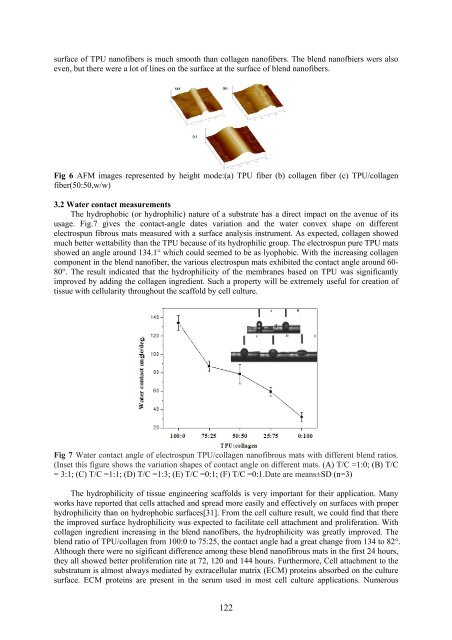Workshop proceeding - final.pdf - Faculty of Information and ...
Workshop proceeding - final.pdf - Faculty of Information and ...
Workshop proceeding - final.pdf - Faculty of Information and ...
Create successful ePaper yourself
Turn your PDF publications into a flip-book with our unique Google optimized e-Paper software.
surface <strong>of</strong> TPU nan<strong>of</strong>ibers is much smooth than collagen nan<strong>of</strong>ibers. The blend nan<strong>of</strong>biers wers also<br />
even, but there were a lot <strong>of</strong> lines on the surface at the surface <strong>of</strong> blend nan<strong>of</strong>ibers.<br />
Fig 6 AFM images represented by height mode:(a) TPU fiber (b) collagen fiber (c) TPU/collagen<br />
fiber(50:50,w/w)<br />
3.2 Water contact measurements<br />
The hydrophobic (or hydrophilic) nature <strong>of</strong> a substrate has a direct impact on the avenue <strong>of</strong> its<br />
usage. Fig.7 gives the contact-angle dates variation <strong>and</strong> the water convex shape on different<br />
electrospun fibrous mats measured with a surface analysis instrument. As expected, collagen showed<br />
much better wettability than the TPU because <strong>of</strong> its hydrophilic group. The electrospun pure TPU mats<br />
showed an angle around 134.1° which could seemed to be as lyophobic. With the increasing collagen<br />
component in the blend nan<strong>of</strong>iber, the various electrospun mats exhibited the contact angle around 60-<br />
80°. The result indicated that the hydrophilicity <strong>of</strong> the membranes based on TPU was significantly<br />
improved by adding the collagen ingredient. Such a property will be extremely useful for creation <strong>of</strong><br />
tissue with cellularity throughout the scaffold by cell culture.<br />
Fig 7 Water contact angle <strong>of</strong> electrospun TPU/collagen nan<strong>of</strong>ibrous mats with different blend ratios.<br />
(Inset this figure shows the variation shapes <strong>of</strong> contact angle on different mats. (A) T/C =1:0; (B) T/C<br />
= 3:1; (C) T/C =1:1; (D) T/C =1:3; (E) T/C =0:1; (F) T/C =0:1.Date are means±SD (n=3)<br />
The hydrophilicity <strong>of</strong> tissue engineering scaffolds is very important for their application. Many<br />
works have reported that cells attached <strong>and</strong> spread more easily <strong>and</strong> effectively on surfaces with proper<br />
hydrophilicity than on hydrophobic surfaces[31]. From the cell culture result, we could find that there<br />
the improved surface hydrophilicity was expected to facilitate cell attachment <strong>and</strong> proliferation. With<br />
collagen ingredient increasing in the blend nan<strong>of</strong>ibers, the hydrophilicity was greatly improved. The<br />
blend ratio <strong>of</strong> TPU/collagen from 100:0 to 75:25, the contact angle had a great change from 134 to 82°.<br />
Although there were no sigificant difference among these blend nan<strong>of</strong>ibrous mats in the first 24 hours,<br />
they all showed better proliferation rate at 72, 120 <strong>and</strong> 144 hours. Furthermore, Cell attachment to the<br />
substratum is almost always mediated by extracellular matrix (ECM) proteins absorbed on the culture<br />
surface. ECM proteins are present in the serum used in most cell culture applications. Numerous<br />
122
















